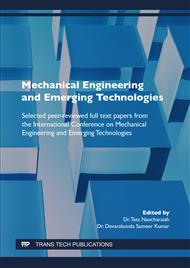[1]
Bozkurt, Y. and Karayel, E., 2021. 3D printing technology; methods, biomedical applications, future opportunities and trends. Journal of Materials Research and Technology, 14, pp.1430-1450.
DOI: 10.1016/j.jmrt.2021.07.050
Google Scholar
[2]
Mostafaei, A., Elliott, A.M., Barnes, J.E., Li, F., Tan, W., Cramer, C.L., Nandwana, P. and Chmielus, M., 2021. Binder jet 3D printing—Process parameters, materials, properties, modeling, and challenges. Progress in Materials Science, 119, p.100707.
DOI: 10.1016/j.pmatsci.2020.100707
Google Scholar
[3]
Birkelid, A.H., Eikevåg, S.W., Elverum, C.W. and Steinert, M., 2022. High-performance polymer 3D printing–Open-source liquid cooled scalable printer design. HardwareX, p.e00265.
DOI: 10.1016/j.ohx.2022.e00265
Google Scholar
[4]
Bhagia, S., Bornani, K., Agrawal, R., Satlewal, A., Ďurkovič, J., Lagaňa, R., Bhagia, M., Yoo, C.G., Zhao, X., Kunc, V. and Pu, Y., 2021. Critical review of FDM 3D printing of PLA biocomposites filled with biomass resources, characterization, biodegradability, upcycling and opportunities for biorefineries. Applied Materials Today, 24, p.101078.
DOI: 10.1016/j.apmt.2021.101078
Google Scholar
[5]
Anton, A., Reiter, L., Wangler, T., Frangez, V., Flatt, R.J. and Dillenburger, B., 2021. A 3D concrete printing prefabrication platform for bespoke columns. Automation in Construction, 122, p.103467.
DOI: 10.1016/j.autcon.2020.103467
Google Scholar
[6]
Bedarf, P., Dutto, A., Zanini, M. and Dillenburger, B., 2021. Foam 3D printing for construction: A review of applications, materials, and processes. Automation in Construction, 130, p.103861.
DOI: 10.1016/j.autcon.2021.103861
Google Scholar
[7]
Singamneni, S., Behera, M.P., Truong, D., Le Guen, M.J., Macrae, E. and Pickering, K., 2021. Direct extrusion 3D printing for a softer PLA-based bio-polymer composite in pellet form. Journal of Materials Research and Technology, 15, pp.936-949.
DOI: 10.1016/j.jmrt.2021.08.044
Google Scholar
[8]
Chen, Y., He, S., Gan, Y., Çopuroğlu, O., Veer, F. and Schlangen, E., 2022. A review of printing strategies, sustainable cementitious materials and characterization methods in the context of extrusion-based 3D concrete printing. Journal of Building Engineering, 45, p.103599.
DOI: 10.1016/j.jobe.2021.103599
Google Scholar
[9]
Luo, C., Xiong, G., Li, Z., Shen, Z., Wan, L., Zhou, M. and Wang, F.Y., 2020. Ordinal Optimization for Optimal Orientation Problems in 3D Printing. IFAC-PapersOnLine, 53(5), pp.97-102.
DOI: 10.1016/j.ifacol.2021.04.086
Google Scholar
[10]
Kantaros, A., Diegel, O., Piromalis, D., Tsaramirsis, G., Khadidos, A.O., Khadidos, A.O., Khan, F.Q. and Jan, S., 2022. 3D printing: Making an innovative technology widely accessible through makerspaces and outsourced services. Materials Today: Proceedings, 49, pp.2712-2723.
DOI: 10.1016/j.matpr.2021.09.074
Google Scholar


